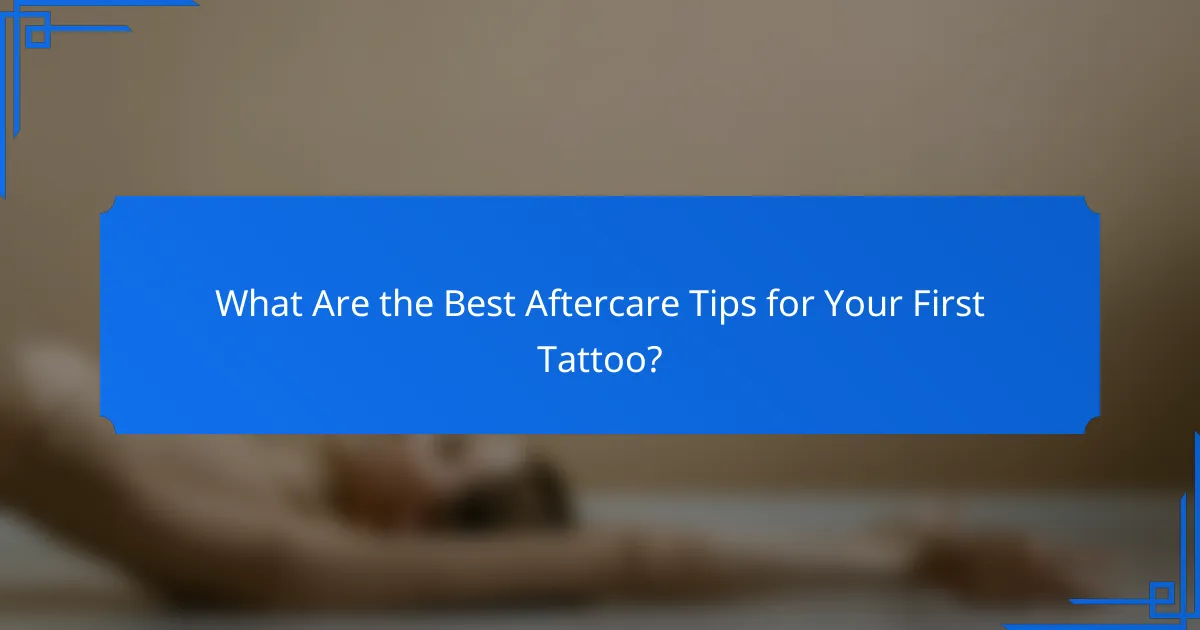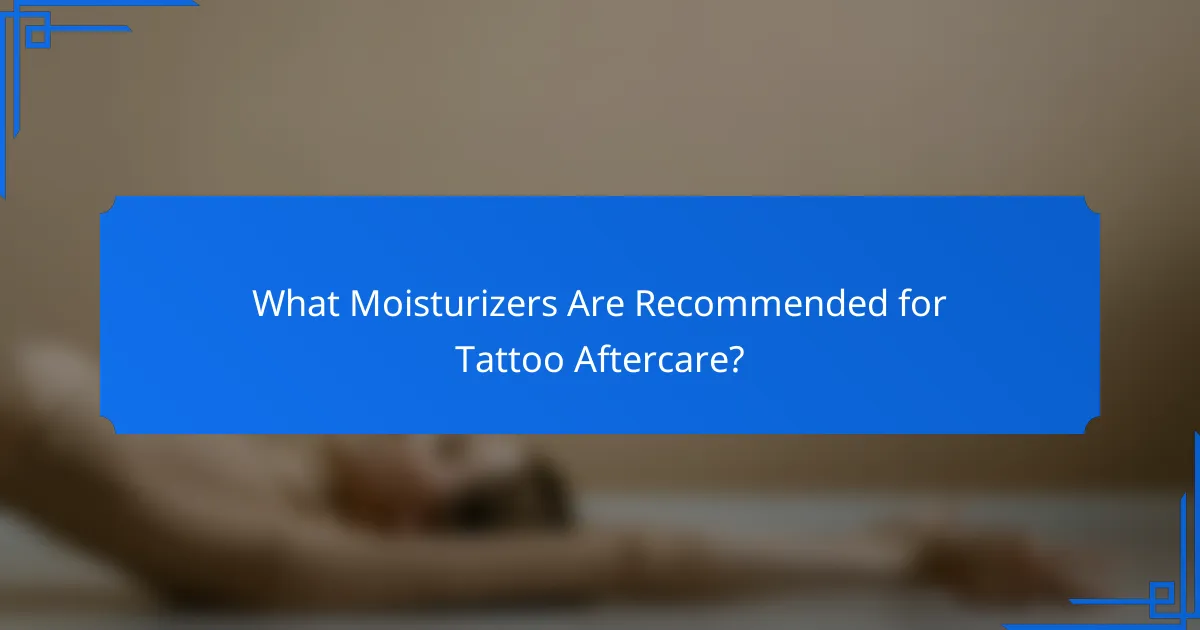Getting your first tattoo is an exciting experience, but proper aftercare is essential to ensure it heals well and retains its vibrancy. By following a few key tips, you can prevent infection and keep your ink looking its best. From cleaning techniques to the right moisturizers, understanding how to care for your new tattoo will make all the difference in its appearance and longevity.

What Are the Best Aftercare Tips for Your First Tattoo?
Proper aftercare is crucial for healing your first tattoo and ensuring it looks its best. Following a few essential tips can help prevent infection and maintain the vibrancy of your ink.
Keep the tattoo clean
Cleaning your tattoo is vital to prevent infection and promote healing. Use mild, unscented soap and lukewarm water to gently wash the area at least twice a day for the first two weeks.
After washing, pat the tattoo dry with a clean towel rather than rubbing it. Avoid soaking the tattoo in water, such as in baths or swimming pools, until it is fully healed.
Moisturize regularly
Keeping your tattoo moisturized helps prevent dryness and promotes healing. Apply a thin layer of fragrance-free lotion or a specialized tattoo aftercare ointment several times a day, especially after washing.
Be cautious not to over-moisturize, as this can lead to clogged pores. A good rule of thumb is to apply moisturizer when the tattoo feels tight or dry.
Avoid direct sunlight
Direct sunlight can fade your tattoo and irritate the healing skin. For at least the first month, keep your tattoo covered or apply a high-SPF sunscreen when you are outdoors.
Once healed, continue to protect your tattoo from the sun to maintain its vibrancy. Reapply sunscreen every two hours if you are spending extended time outside.
Do not pick at scabs
As your tattoo heals, it may form scabs, which are a natural part of the process. Picking at these scabs can lead to scarring and color loss, so it’s essential to let them fall off naturally.
If you notice excessive itching, gently tap the area instead of scratching. Keeping the tattoo moisturized can also help alleviate discomfort.
Wear loose clothing
Wearing loose-fitting clothing over your tattoo can help prevent irritation and allow the skin to breathe. Tight clothing can rub against the tattoo, causing discomfort and potentially affecting the healing process.
Choose breathable fabrics, especially in the first few weeks, to promote healing and avoid trapping moisture against the skin.

How Should You Clean Your Tattoo?
Cleaning your tattoo properly is crucial for healing and preventing infection. Start the cleaning process as soon as your tattoo artist removes the bandage, using gentle techniques and appropriate products.
Use mild soap
When cleaning your tattoo, opt for a mild, fragrance-free soap to avoid irritation. Look for products labeled as gentle or suitable for sensitive skin, as these will help maintain moisture without causing discomfort.
Apply the soap with clean hands, using lukewarm water to create a lather. Gently wash the tattooed area, avoiding scrubbing or harsh movements that could damage the skin.
Pat dry with a clean towel
After washing, it’s important to dry your tattoo carefully. Use a clean, soft towel to pat the area dry instead of rubbing it, which can irritate the skin and disrupt the healing process.
Ensure the towel is free from lint and dirt to prevent any potential infection. Allow the tattoo to air dry for a few minutes before applying any aftercare products, ensuring it is completely dry to promote optimal healing.

What Moisturizers Are Recommended for Tattoo Aftercare?
For effective tattoo aftercare, it’s essential to use moisturizers that promote healing and protect the skin. Recommended options include fragrance-free lotions and natural oils like coconut oil, which help keep the tattoo hydrated and prevent irritation.
Fragrance-free lotion
Fragrance-free lotions are ideal for tattoo aftercare as they minimize the risk of irritation and allergic reactions. Look for products that contain ingredients like aloe vera or shea butter, which are known for their soothing properties.
Apply a thin layer of fragrance-free lotion to the tattooed area 2-3 times a day, especially after washing. Avoid over-applying, as this can clog pores and lead to breakouts.
Natural oils like coconut oil
Coconut oil is a popular choice for tattoo aftercare due to its natural antibacterial properties and ability to deeply moisturize the skin. It helps maintain skin elasticity and can promote faster healing.
Use coconut oil sparingly, applying a small amount to the tattooed area once or twice daily. Ensure the oil is organic and free from additives to avoid any adverse reactions. If you notice any irritation, discontinue use and consult a professional.

How Long Should You Avoid Sun Exposure?
To protect your new tattoo, you should avoid sun exposure for at least two weeks after getting it. Sunlight can cause fading and irritation, which may hinder the healing process and affect the tattoo’s appearance.
At least 2 weeks
For the first two weeks, keep your tattoo covered when outdoors, especially during peak sunlight hours. This period is crucial as your skin is healing and more susceptible to damage from UV rays.
After the initial healing phase, you should still be cautious. If you plan to be in the sun, consider wearing protective clothing or seeking shade whenever possible.
Use sunscreen after healing
Once your tattoo has fully healed, applying sunscreen is essential to maintain its vibrancy. Choose a broad-spectrum sunscreen with an SPF of at least 30 to protect against both UVA and UVB rays.
Reapply sunscreen every two hours when exposed to sunlight, and more frequently if swimming or sweating. This will help prevent fading and keep your tattoo looking fresh for years to come.

What Are the Signs of Infection?
Signs of infection in a new tattoo can include increased redness, pus or unusual discharge, and persistent pain. Recognizing these symptoms early is crucial for effective treatment and to prevent complications.
Increased redness
Increased redness around a tattoo can indicate an infection, especially if the redness expands beyond the initial tattoo area. While some redness is normal during the healing process, a significant increase or a change in color intensity may warrant attention.
Monitor the redness over a few days. If it continues to grow or does not begin to fade after the first week, consult a healthcare professional for advice.
Pus or unusual discharge
Pus or any unusual discharge from a tattoo site is a common sign of infection. Healthy tattoos may have some clear fluid, but yellow or green discharge typically signals a problem.
If you notice pus, keep the area clean and dry. Avoid picking at the tattoo and seek medical advice promptly to prevent further complications.

How Can You Prevent Fading Over Time?
To prevent fading of your tattoo over time, proper aftercare and ongoing maintenance are essential. This includes following specific care instructions and protecting your skin from sun exposure.
Follow aftercare instructions
Adhering to the aftercare instructions provided by your tattoo artist is crucial for preserving the vibrancy of your tattoo. This typically involves keeping the tattoo clean, applying a suitable ointment, and avoiding picking at scabs.
Most artists recommend washing the tattoo gently with mild soap and water, then applying a thin layer of a healing ointment for the first few weeks. Following these steps can significantly reduce the risk of fading and ensure the ink settles properly.
Stay hydrated
Staying hydrated plays a vital role in maintaining skin health, which in turn helps your tattoo look fresh. Drinking adequate water supports skin elasticity and can prevent dryness that may lead to fading.
Aim for at least 2 liters of water daily, adjusting based on your activity level and climate. Proper hydration not only benefits your tattoo but also enhances your overall skin appearance.

What Should You Do if Your Tattoo Starts to Itch?
If your tattoo begins to itch, it’s a normal part of the healing process. However, it’s crucial to manage the itching properly to avoid damaging the tattoo and ensure it heals well.
Apply a fragrance-free moisturizer
Using a fragrance-free moisturizer can help alleviate itching by keeping the skin hydrated. Look for products specifically designed for sensitive skin to avoid irritation. Apply a thin layer to the tattooed area as needed, but avoid over-moisturizing, which can lead to other skin issues.
Consider using a moisturizer that contains ingredients like aloe vera or vitamin E, as these can soothe the skin and promote healing. Always check the product label to ensure it is free from fragrances and harsh chemicals.
Avoid scratching
Scratching the tattooed area can lead to scarring and may compromise the design. Instead of scratching, try gently tapping or patting the area to relieve the urge. If the itchiness becomes unbearable, consider applying a cool compress to soothe the skin.
Keep your nails trimmed and clean to minimize the risk of infection if you accidentally scratch. If the itching persists or worsens, consult your tattoo artist or a healthcare professional for advice on appropriate treatments.


